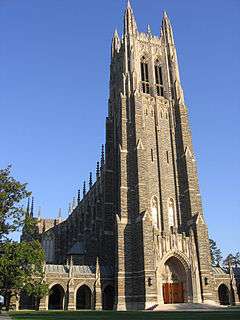Duke Lemur Center
| Duke Lemur Center | |
|---|---|
 | |
| Type | Center to promote research and understanding of prosimians |
| Location |
3705 Lemur Lane Duke Forest Duke University |
| Created | 1966[1] |
| Website |
lemur |

The Duke Lemur Center is an 85-acre (34 ha) sanctuary for rare and endangered prosimian primates, located at Duke University in Durham, North Carolina. It is the largest sanctuary for prosimian primates in the world.[1]
The center is open to the public through tours, for which visitors must make an appointment.[2][3]
History
In 1966, a prosimian colony of approximately 90 individuals, belonging to John Buettner-Janusch, was relocated from the Center for Prosimian Biology at Yale University to Duke University, creating the Duke Lemur Center (DLC). Through the 1970s, the colony grew to approximately 700 individuals representing 33 species. The current colony ranges between 250 and 300 animals, representing approximately 25 species.[4] Originally called the Duke University Primate Center (DUPC), the center's name was changed in April 2006 after a refocusing of the scientific goals and overall mission. Specimens from its scientific collection may thus be assigned the code DPC.[5][6]
The mission of the Duke University Lemur Center is to "promote research and understanding of prosimians and their natural habitat as a means of advancing the frontiers of knowledge, to contribute to the educational development of future leaders in international scholarship and conservation and to enhance the human condition by stimulating intellectual growth and sustaining global biodiversity."[1]
According to Duke University, the Lemur Center, the only university-based facility in the world devoted to the study of strepsirrhine primates, "is home to the world's largest colony of endangered primates – including more than 200 lemurs, bush babies and lorises.... More than 85 percent of the center's inhabitants were born on site."[7]
In 1997, the center began a program to reintroduce black-and-white ruffed lemurs into the 5,500-acre (2,200 ha) Betampona Natural Reserve in Madagascar, the first return of any prosimian primates to the island nation.[8]
In 2009 and 2010, the center completed two new buildings for housing lemurs. The first building was completed in 2009 and is a 14,922-square-foot (1,386.3 m2) facility (including exterior animal runs) with 7,056 square feet (655.5 m2) of interior space. It can house up to 60 animals that can be released into the 69-acre (28 ha) Duke Forest if weather permits. The second building was completed in 2010 and is a 20,637-square-foot (1,917.2 m2) facility (including exterior animal runs) with 9,883 square feet (918.2 m2) of interior space. Together, they are able to house 140 lemurs. The buildings are designed with animal housing wings radiating from a central core which houses common resources like laboratories, exam rooms, food prep, bathrooms, and storage spaces. Both buildings are designed for low water and electricity use, and are LEED registered. The total cost of the two-buildings, designed by architects Lord, Aeck & Sargent of Chapel Hill, North Carolina, was $10.4 million.[9]
Lemurs occasionally escape from its natural habitat enclosures.[10]
On November 10, 2014, Jovian, the Coquerel's sifaka best known for mainly portraying Zoboomafoo in the series of the same name, died of renal failure in his home at the Duke Lemur Center at the age of 20.[11]
References
- 1 2 3 "About the Duke Lemur Center". lemur.duke.edu. Duke University. Retrieved 27 May 2011.
- ↑ "Directions". lemur.duke.edu. Duke University. Retrieved 27 May 2011.
- ↑ "Betampona Reserve and the Ruffed Lemur Re-stocking Program". lemur.duke.edu. Duke University. Retrieved 27 May 2011.
- ↑ Mooney, Ashley (2014-04-16). "History of the Duke Lemur Center". The Chronicle. Retrieved 2015-10-26.
- ↑ Stidham, Thomas A.; Smith, N. Adam (2015). "An ameghinornithid-like bird (Aves, Cariamae, Ameghinornithidae) from the early Oligocene of Egypt". Palaeo Electronica. Retrieved 2015-10-26.
- ↑ "Craniodental Morphology and Systematics of a New Family of Hystricognathous Rodents (Gaudeamuridae) from the Late Eocene and Early Oligocene of Egypt". Morpho Bank. 2012-08-07. Retrieved 2015-10-26.
- ↑ "Duke University at a Glance". Duke University. Retrieved 14 November 2014.
- ↑ "Tours". lemur.duke.edu. Duke University. Retrieved 25 July 2011.
- ↑ "Duke Univ., Duke Lemur Center, Durham, N.C.". Laboratory Design Newsletter. 15 February 2011. Retrieved 25 July 2011.
- ↑ "Lemur escapes on five-hour ramble in Durham". WRAL. 24 May 2013. Archived from the original on 24 August 2013. Retrieved 17 August 2013.
- ↑ Deutsch, Lindsay. "Internet mourns loss of celebrity lemur Zoboomafoo". USA Today.
External links
| Wikimedia Commons has media related to Duke Lemur Center. |
- Official website
- Duke University
- Nature: The Loneliest Animals (Chapter 4): Lemur survival in captivity at the Duke Lemur Center
